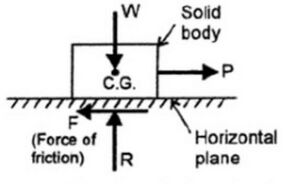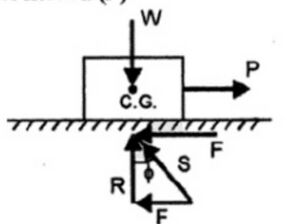Friction
When a solid body slides over a stationary solid body, a force is exerted at the surface of contact by the stationary body on the moving body. This force is called as the force of friction and is always acting in the direction opposite to the direction of motion. Friction is a property of the bodies by virtue of which a force is exerted by a stationary body on the moving body to resist the motion of the moving body. Friction acts parallel to the surface of contact and depends on the nature of surface of contact.
The different contact surfaces are i) dry ii) partially lubricated (greasy) iii) completely lubricated (film lubricated).
Force of friction should be reduced or increased. Reducing the force of friction is needed when the power transmitted is partially lost due to friction, the friction must be reduced by using lubricated surfaces.
Terminology
Consider a solid body placed on a horizontal plane surface.
W = Weight of body acting through centre of gravity downward,
R = Normal reaction of body acting through centre of gravity upward,
P = Force acting on the body through centre of gravity parallel to the horizontal surface
if the force P is small , the body will not move as the force of friction F acting on the body in the opposite direction of force P will be more than P. But if the force P is increased at some point when the solid body is on the point of motion.
Limiting force of friction
At that point force of friction F acting on the body is called limiting force of friction. Limiting force of friction is denoted by F.
By resolving the horizontal and vertical forces acting on the body we get R = W and F = P
Kinetic Friction
if the force P is increased further the body will start moving. The force of friction acting on the body, when the body is moving is called Kinetic Friction.
Coefficient of Friction (μ)
F = μR
Ange of Friction (Φ)
Angle of friction is the angle made by the resultant of the normal reaction (R) and the limiting force of Friction (F) with the normal reaction (R) which is denoted by Φ.

